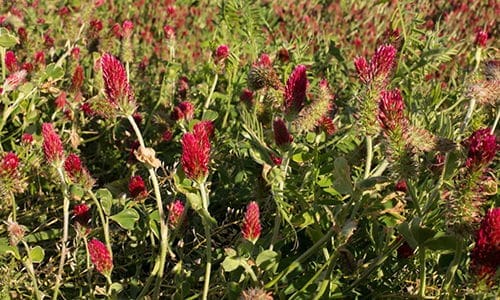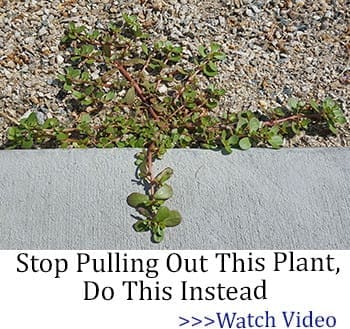If you ask homesteaders what they least like about gardening, they would most likely say weeding, weeding, and more weeding. Yes, that’s right!
So, what can gardeners do about all of those weeds? Mulch is the answer that comes to mind.
The #1 purpose of using mulch is to help keep weeds at bay. Other main advantages include holding in much-needed moisture and buffering the roots of the plants from the hot sun.
Many people traditionally buy bark mulch which is dyed and shredded. However, bark mulch does not enrich the soil nor retain as much moisture as living mulch. It is purely decorative. In addition, bark mulch is quite costly. It is also time-consuming and labor-intensive to buy and spread the bark mulch.
Besides bark mulch, gardeners often buy stones. Again, there is a high cost as well as time and labor factors.
In contrast, living mulch can be easily grown in your garden and has lots of superior benefits.
Using living mulch is not new. It is similar to choosing companion plants to protect other plants from overgrazing, disease, and insects, and it can enhance root and fruit development. Living mulch is the smart, ecological alternative to mulching your garden.
The Type Of Mulch You Can Find In Your Yard
Dried materials like grass clippings, dead leaves, pine cones, and pine needles found in your yard can be used as mulch. Although these are organic materials, you should consider using another plant as a cover crop. This crop serves as mulch to combat weeds.
Related: Stop Throwing Away Old Newspapers. Do This Instead

What Is Living Mulch
Living mulch also known as green mulch is a low-growing groundcover planted with your main crops but beneath them to keep out the weeds. These crops planted as living mulch have many other benefits.
Benefits Of Living Mulch
Besides suppressing weeds, living mulch helps retain water and improves the soil. Since the crops are grown in the soil, the root system holds everything in place rather than merely covering the soil (like storebought mulch – bark, stones, etc.).
In addition, living mulch allows for microbes and fungi to grow which, in turn, helps grow healthy garden crops. Also, the mulch can attract different pollinators and beneficial insects that eat the bugs that love to feast on your plants. The added species of plants growing together create a natural space: butterflies can find flowers to feed from and host plants to lay eggs on while birds can find a place to nest and forage on the plants and insects they support.

How You Can Grow It
How do you begin? You can plant seeds for living mulch a few weeks after your garden crops have been growing so they are established before the mulch begins to grow. Make sure the area is weed-free and the soil is loose and well-drained. Read the seed packet recommendations about seed depth and then sow the seeds. Provide water during the first few weeks until the crop (living mulch) matures.
How Do You Best Sow The Living Mulch?
You can add the seeds after you plant your vegetable garden. Consider the height of your vegetables so the living mulch doesn’t overtake the vegetable plants. Also, be cognizant that the living mulch does not provide too much-unwanted shade and dwarfs your garden plants. If there are walking paths in your garden, sow low-growing mulch like clover.
Don’t be afraid to experiment with different types of living mulch that best match your growing season and the specific vegetables you intend to grow. For example, let’s consider the climate.
For gardeners in hot and dry climates, a thicker layer of mulch is needed to retain moisture and provide protection from the hot sun.
Gardeners in cool and wet climates should use a thinner layer of mulch. This protects the soil from being washed away as well as allows excess moisture to evaporate. It also helps prevent fungal issues from thicker mulches that may be used in cool, wet climates which attract unwanted annoying snails and slugs.

Best Crops For Living Mulch
Red and white clover, Roman chamomile, buckwheat, and alfalfa are ideal crops. You can elect to use one crop or combine several of them.
Another option is to fill in the bare spots of your garden with annual flowers or even herbs. If you want the mulch to be a groundcover, consider wooly thyme or creeping red fescue as these species can handle a lot of foot traffic. A combination of legumes and grasses also works well. They can double as a food crop and also repel common vegetable pests.

How Else Can You Enrich The Soil Naturally?
Besides growing living mulch, you can enrich your soil by using the garden crops in your garden.
At the end of the growing season, you can chop the garden crops and leave them on top of the soil to decompose. Leave the roots in place. Smaller vining crops work especially well. Think of your cucumbers, squash, and zucchini. These vines break down over the fall and winter seasons and add nutrients back into the soil for next year’s spring/summer garden.
Since there are so many advantages to using living mulch, you should try a variety of mulching options to find what works best for you and your garden!
Using plants as living mulch is a great choice to reduce weeds. What’s more? Your gardens will be more attractive to birds, butterflies, bees, pollinators, and other creatures.
You can also reduce the time spent laying the mulch, getting rid of the weeds, and retaining water. Your soil will be enriched and your plants will flourish.
In the end, you will have a beautiful and diverse garden and help the environment in the long run. So many pluses!
Why don’t you give living mulch a try this garden season? I know I sure will.
You may also like:
 13 Homemade Fertilizers For Your Plants
13 Homemade Fertilizers For Your Plants
Similar to Morphine: The Best Natural Painkiller that Grows in Your Backyard (Video)
Stop Doing This To Your Soil Right Now








